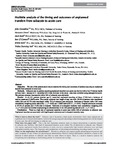Multisite analysis of the timing and outcomes of unplanned transfers from subacute to acute care
| dc.contributor.author | Considine, J | |
| dc.contributor.author | Street, M | |
| dc.contributor.author | Botti, M | |
| dc.contributor.author | O'Connell, B | |
| dc.contributor.author | Kent, B | |
| dc.contributor.author | Dunning, T | |
| dc.date.accessioned | 2016-12-16T18:36:40Z | |
| dc.date.available | 2016-12-16T18:36:40Z | |
| dc.date.issued | 2015 | |
| dc.identifier.issn | 0156-5788 | |
| dc.identifier.issn | 1449-8944 | |
| dc.identifier.uri | http://hdl.handle.net/10026.1/8142 | |
| dc.description.abstract |
<jats:p>Objective The aim of the present study was to examine the timing and outcomes of patients requiring an unplanned transfer from subacute to acute care. Methods Subacute care in-patients requiring unplanned transfer to an acute care facility within four Victorian health services from 1 January to 31 December 2010 were included in the study. Data were collected using retrospective audit. The primary outcome was transfer within 24 h of subacute care admission. Results In all, 431 patients (median age 81 years) had unplanned transfers; of these, 37.8% had a limitation of medical treatment (LOMT) order. The median subacute care length of stay was 43 h: 29.0% of patients were transferred within 24 h and 83.5% were transferred within 72 h of subacute care admission. Predictors of transfer within 24 h were comorbidity weighting (odds ratio (OR) 1.1, P = 0.02) and LOMT order (OR 2.1, P < 0.01). Hospital admission occurred in 87.2% of patients and 15.4% died in hospital. Predictors of in-hospital mortality were comorbidity weighting (OR 1.2, P < 0.01) and the number of physiological abnormalities in the 24 h preceding transfer (OR 1.3, P < 0.01). Conclusions There is a high rate of unplanned transfers to acute care within 24 h of admission to subacute care. Unplanned transfers are associated with high hospital admission and in-hospital mortality rates. What is known about the topic? Subacute care is becoming a high acuity environment where many patients are at significant risk of clinical deterioration. Systems for recognising and responding to deteriorating patients are well developed in acute care, but still developing in subacute care. What does this paper add? This is the first Australian multisite study of clinical deterioration in patients situated in subacute care facilities. One-third of unplanned transfers occur within 24 h of admission to subacute care. Patients who require unplanned transfer from subacute to acute care have unexpectedly high hospital admission rates and high in-hospital mortality rates. The frequency and completeness of physiological monitoring preceding transfer was low. What are the implications for practitioners? Patients in subacute care require regular physiological assessment and early escalation of care if there are physiological abnormalities. Risk of clinical deterioration should be a factor in the decision to admit patients to subacute care after an acute illness or injury. There is a need to improve systems for recognising and responding to deteriorating patients in subacute care settings.</jats:p> | |
| dc.format.extent | 387-387 | |
| dc.format.medium | ||
| dc.language | en | |
| dc.language.iso | eng | |
| dc.publisher | CSIRO Publishing | |
| dc.subject | clinical deterioration | |
| dc.subject | patient safety | |
| dc.subject | rapid response | |
| dc.subject | risk management | |
| dc.subject | transitions in care | |
| dc.title | Multisite analysis of the timing and outcomes of unplanned transfers from subacute to acute care | |
| dc.type | journal-article | |
| dc.type | Journal Article | |
| dc.type | Multicenter Study | |
| dc.type | Research Support, Non-U.S. Gov't | |
| plymouth.author-url | https://www.webofscience.com/api/gateway?GWVersion=2&SrcApp=PARTNER_APP&SrcAuth=LinksAMR&KeyUT=WOS:000360660800005&DestLinkType=FullRecord&DestApp=ALL_WOS&UsrCustomerID=11bb513d99f797142bcfeffcc58ea008 | |
| plymouth.issue | 4 | |
| plymouth.volume | 39 | |
| plymouth.publication-status | Published | |
| plymouth.journal | Australian Health Review | |
| dc.identifier.doi | 10.1071/ah14106 | |
| plymouth.organisational-group | /Plymouth | |
| plymouth.organisational-group | /Plymouth/Faculty of Health | |
| plymouth.organisational-group | /Plymouth/Faculty of Health/School of Nursing and Midwifery | |
| plymouth.organisational-group | /Plymouth/REF 2021 Researchers by UoA | |
| plymouth.organisational-group | /Plymouth/REF 2021 Researchers by UoA/UoA03 Allied Health Professions, Dentistry, Nursing and Pharmacy | |
| plymouth.organisational-group | /Plymouth/Research Groups | |
| plymouth.organisational-group | /Plymouth/Research Groups/Institute of Health and Community | |
| plymouth.organisational-group | /Plymouth/Research Groups/Plymouth Institute of Health and Care Research (PIHR) | |
| plymouth.organisational-group | /Plymouth/Users by role | |
| plymouth.organisational-group | /Plymouth/Users by role/Academics | |
| dc.publisher.place | Australia | |
| dcterms.dateAccepted | 2015-11-05 | |
| dc.identifier.eissn | 1449-8944 | |
| dc.rights.embargoperiod | No embargo | |
| rioxxterms.versionofrecord | 10.1071/ah14106 | |
| rioxxterms.licenseref.uri | http://www.rioxx.net/licenses/all-rights-reserved | |
| rioxxterms.licenseref.startdate | 2015-09 | |
| rioxxterms.type | Journal Article/Review |


